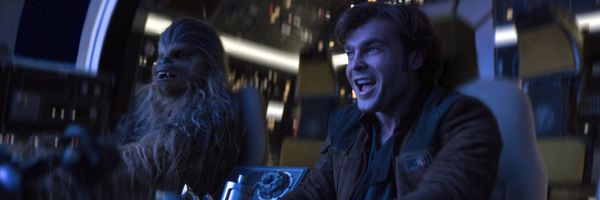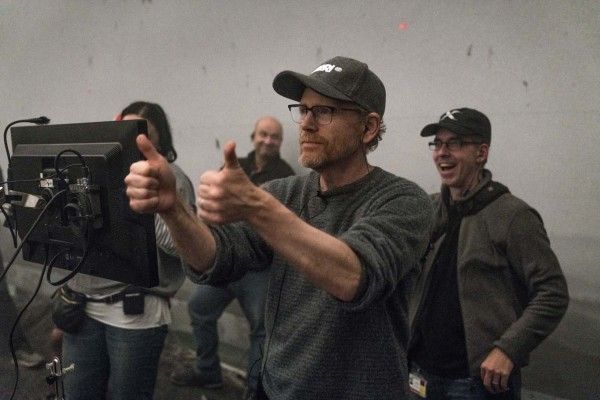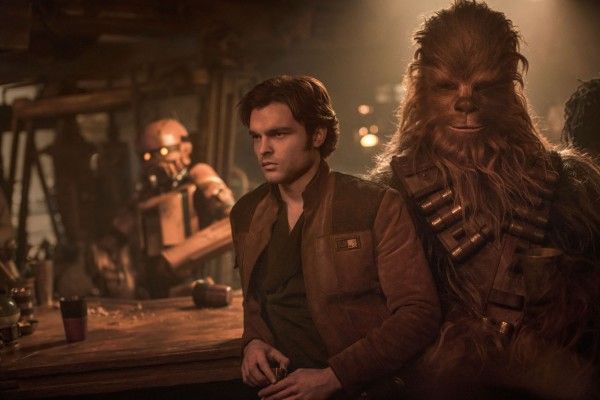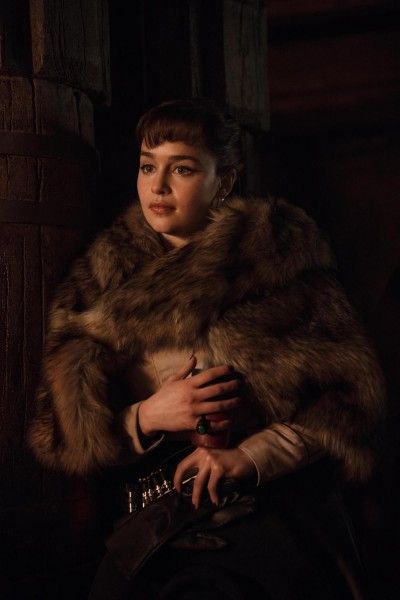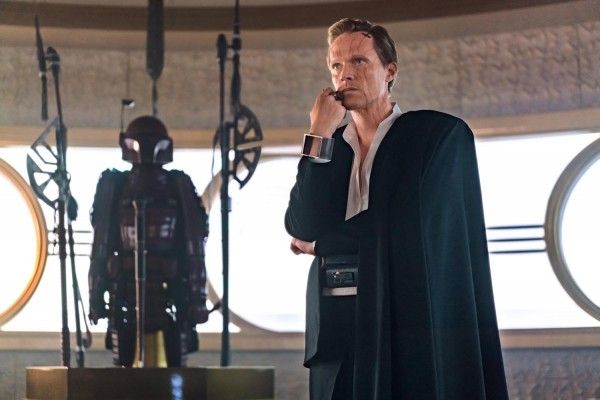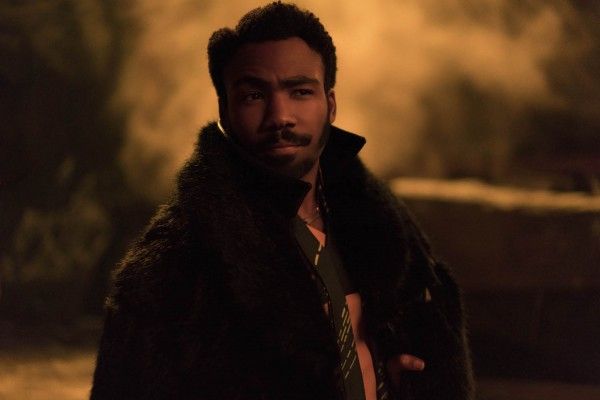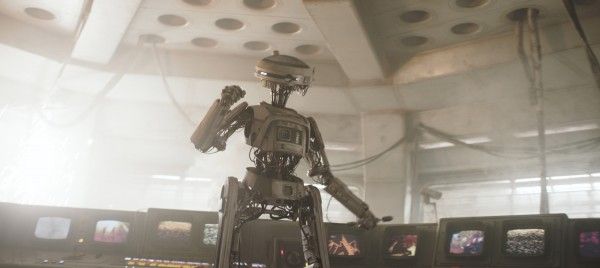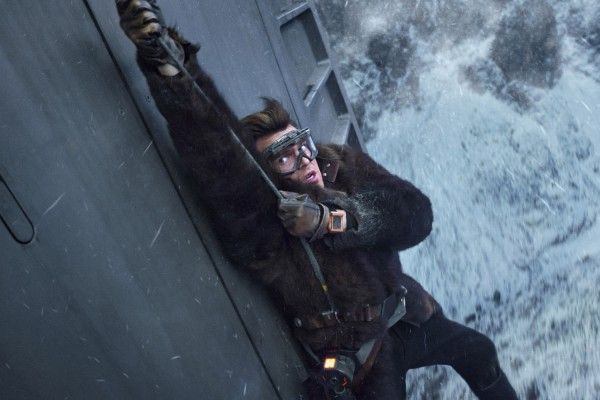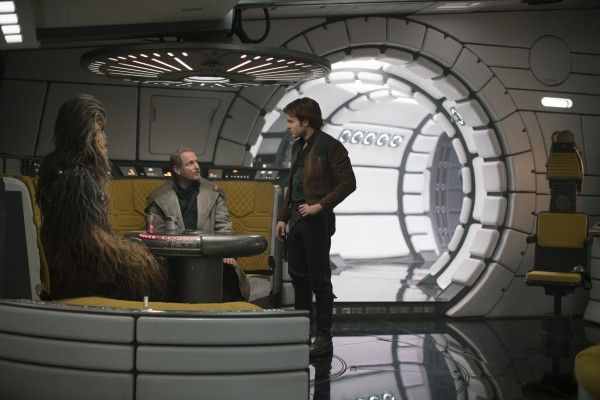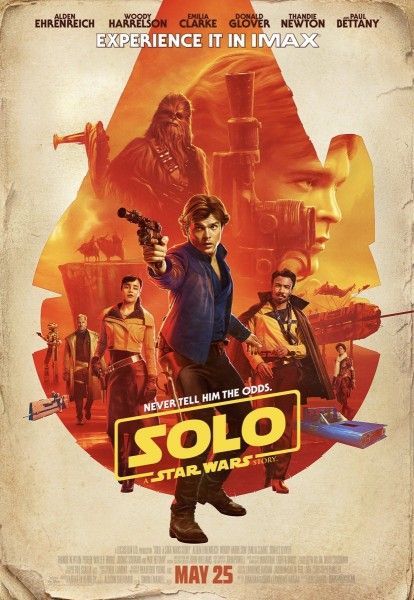From director Ron Howard and screenwriters Lawrence & Jonathan Kasdan, Solo: A Star Wars Story delves into the past of the beloved, iconic character Han Solo (Alden Ehrenreich) to take audiences on an adventure, deep into the dark and dangerous criminal underworld. Through a series of daring escapades, fans will get to learn about the history and background of the charismatic pilot through his relationships and friendships, whether that’s with Qi’ra (Emilia Clarke), Tobias Beckett (Woody Harrelson), his future co-pilot Chewbacca (Joonas Suotamo), or notorious gambler Lando Calrissian (Donald Glover).
At a conference at the film’s press junket, held at the Pasadena Convention Center, co-stars Alden Ehrenreich, Donald Glover, Emilia Clarke, Woody Harrelson, Thandie Newton (“Val”), Paul Bettany (“Dryden Vos”), Phoebe Waller-Bridge (“L3") and Joonas Suotamo were joined by director Ron Howard and screenwriters Lawrence and Jonathan Kasdan to talk about the level of anticipation that comes with making a Star Wars movie, stepping into the cockpit of the Millennium Falcon, hugging Chewbacca, making such an inspiring droid, practical sets vs. visual effects, Lando’s affinity for capes, and balancing what fans want to see with making the film its own thing.
Question: Ron, you’ve made some huge films and you’ve made some of the greatest movies of all time. What was it like making a Star Wars movie? How was that different?
RON HOWARD: It’s the galaxy far, far away. The level of anticipation is really unlike anything I’ve done, and I’ve done some pretty big titles with a lot of interest. It’s amazing! I’m at a point in my life where I like experimenting. I like to take some chances, and I’m not too worried about the outcome. I want to have the creative experience, and I felt that way about jumping into a Star Wars movie, but I also felt that way about jumping into the Beatles documentary. From the moment it was announced, it was, “Ron, don’t fuck this up!” Of course, you know that the fans care, and they should care.
Lawrence and Jonathan, when the two of you sat down together to write this, was this a story that had been bubbling in your head for awhile, or did you sit down and create it fresh?
LAWRENCE KASDAN: The story hadn’t been bubbling for a long time. What had been bubbling, for me, from when I was relatively young and I first saw Han Solo in the cantina, was that I immediately sparked to him. He lifted up the whole movie, instantly, and I loved the movie. At that moment, I thought, “This movie’s got me.” This is the kind of character that I have always loved and has been so important in all the movies that I care about. This is a character who’s reckless, who’s cynical and who doesn’t trust anybody. I love that. He just does things hat he shouldn’t do. He gets in over his head, and you can see that, in the brilliance of George Lucas’s cantina scene. It’s just a few minutes, but you get everything about who this guy is.
JONATHAN KASDAN: Larry had decided to get involved in Star Wars, based on Han. That was the movie he wanted to make first, but he got pulled into Force Awakens. When he came out, he said, “I need somebody to do this with me,” and I was the obvious choice because I also shared a deep love of this, but I came at it from a totally different place than Larry did. I had grown up with Star Wars and I’d grown up playing with the toys. We thought that somehow between our two dynamics – with me as a fan and him as an older Jedi master – we could figure out some sort of dynamic where we could forge a story that felt both contemporary and true to the spirit of Solo.
Alden, what did it feel like for you to step into and sit down in the cockpit of the Millennium Falcon?
ALDEN EHRENREICH: It’s really wild and really exciting. It’s bigger than you can even wrap your head around. It’s wonderful. Particularly being in the Millennium Falcon is very, very cool. You get into the cockpit and you can’t believe you’re in it. It’s so surreal, and that’s what everybody you bring to set wants to see, so that they can have that experience, too. And then, a couple months into shooting in it, you’re inside of it and you’re flying it, you know where the buttons are and how the chair feels, and you’re like, “This my ship now!” That’s deeply gratifying.
Donald, you were a big Star Wars fan and your father was a huge Lando fan. What was it like for you to step into the shoes of Lando? Is this a character that you ever pictured yourself taking on?
DONALD GLOVER: As much as any seven-year-old boy does, of course, you pretend to be him. I had a Darth Vader and he had a light saber, and I bit it off and gave it to Lando. And then, my mom wouldn’t let me have the light saber anymore because she thought I’d choke on it. So, this was really cool. When I heard they were making these films, I told my agent, “If they’re making anything with Lando in it, I have to be Lando!” He was like, “I hear you, but I don’t like your odds.” And that was exactly what I needed to hear. I auditioned like it was the only role I wanted, in the world, because it really was. So, I’m just really happy to be part of this experience. It’s really cool. My dad imprinted me with this Star Wars longing. It feels like the Bible to me, in a lot of ways.
Joonas, any time you’re in the Chewbacca costume, people want a hug. What’s it like to play such an incredibly loved character?
JOONAS SUOTAMO: When I got to know that I was going to be playing this character, I really couldn’t sleep at night. I was so excited because this was a life-changer for me. I was borderline jobless when I got this role. My now fiancée, and then girlfriend, has seen me going from living with my mom to becoming Chewbacca. That’s the span of our relationship. It’s funny how this character is so loved. Peter Mayhew, who created this character, along with George Lucas, has been so instrumental in helping me and giving me his blessing. He gave me some tips, in our week-long session together, on how to be this character. It was fun. I never could have understood what went on underneath the mask of Peter Mayhew. Getting to know that, it was so easy, going into shooting this film, which is so much about Han and Chewie. It was so important to get that right, for this film.
Emilia, your character, Qi’ra, has such an air of mystery around her. What was it like to play that and explore her relationship with Han and the rest of the gang?
EMILIA CLARKE: Playing mysterious is quite a difficult note, I’ve got to be honest. It was really fun. It’s really difficult to talk about because she is a pretty mysterious character. You need to keep tabs on her, throughout the movie. She is one of the harder [characters] to discuss. We meet her, quite early on, with Han, and then they’re separated, for whatever reason, and when we find her again, she seems to have lived a pretty dark life, in that time. You can’t quite figure out what it is that’s happened to her, in the time that you haven’t been with her, and who it is that she is now. That’s a question that keeps coming up, throughout the movie.
Woody, how did you find the experience of playing Tobias Beckett? How did you view him?
WOODY HARRELSON: It was a really easy character for me to play. He’s a scoundrel and a thief, but he’s really well-written. Larry and Jonathan wrote an extraordinary script, and then Ron came in and did his magic, and you have all of these wonderful characters. It’s pretty cool to get to be in a Star Wars movie. It’s phenomenal.
Thandie, what did you enjoy about playing Val and working with her crew?
THANDIE NEWTON: We had fun! The production design was so amazing that we would feel like we were in real battle scenarios with explosions going off and debris and mud in places that you didn’t even know you had. And there was always humor. We were really going into battle together. It’s obviously a fantasy, fun battle, we were still going into battle.
Phoebe, L3 is not like any droid we’ve ever seen in Star Wars before. What makes her special?
PHOEBE WALLER-BRIDGE: L3 is a real inspiration to me. She’s a self-made droid. She created herself out of parts of other droids, which sounds frightening, when I put it like that. She turned herself into a unique creature that’s taller, stronger and more independent than she originally was. She’s got a great attitude and she’s very upbeat. She’s really fun to be around. She’s fearless, uncensored and very funny, and she’s a revolutionary. She has an agenda, which is bigger than the sum of her parts. That’s something that’s really extraordinary, and it’s great to play that. It’s great to play a droid with a message. She’s great!
Paul, Dryden Vos is a legitimately terrifying man. How did you approach him, and what did you want to do with the character?
PAUL BETTANY: He was a lot of fun to play. It was written really beautifully. Ron whispered “Oligarch” in my ear, and I went, “Got it!” Having come from Avengers, where Vision is fundamentally good, it was just lovely to play somebody who’s deliciously bad. He’s really okay with it. There’s no neurosis and no guilt. He’s just super happy about being evil. He’s really good at hurting people, too. Some people are really good at piano, and some have different talents.
Ron, Star Wars movies are known for incredible practical sets and visual effects. How did you feel about combining the two? Did you want to lean more towards one than the other?
HOWARD: As great as visual effects and CGI are, in-camera is always what you want to go for first. And so, with the Millennium Falcon and the great sets, the approach was always to try to get as much in-camera as you could. That’s what’s so magical and amazing about ILM and what they can do to make the experience as palpable and immersive as it could possibly be. It’s a blast! The people around a movie like Solo are so dedicated to not just what’s existed before, but what else they could do within that framework, universe and galaxy. Creatively, it’s unbelievably stimulating for a filmmaker. And Bradford Young did a great job. The look is a little different than how the movies have looked before. It’s an aesthetic that I thought was incredibly exciting.
Since you came to this movie late, how hard was it to find the perfect role for your brother Clint?
HOWARD: Well, it was pretty damn easy. I did come into it late. There was a lot of work that Phil [Lord] and Chris [Miller] had done, but there were circumstances where they were not going to carry on. Within that, there were a lot of things that were really strong and that already worked, and we knew that we wanted to keep that in, and there were other things that hadn’t been done yet. I was given the opportunity to experiment and explore, so I sat down with Larry and Jon and we started talking about this, that and the other. And then, this great scene with L3 came up in conversation. L3 needed somebody to be pissed off at, and I said, “My brother!” He is easy to be pissed off at, and he’s funny when he’s doing it. I love working with him. He’s a great character actor. He’s funny, he’s smart, and he’s a great team player. He’s not in all of my movies because if there’s not something really juicy and fun for him to do, then of course, I don’t cast him. But in this case, I knew it would be fun and, and he had a blast doing it.
Alden, did you watch what Harrison Ford had done with this character and study his movements, at all, or did you avoid that?
EHRENREICH: The way I went about it was to watch the original movies, very early on, and just absorb as much as I could, of how the character operates in the world. The whole Star Wars universe is so rich and there’s so much to it that I tried to take in as much of that as I could. I had the role for quite a long time before we actually shot. And then, when I started working on the part, I had to put all of that aside and forget about it, and play this guy where he is now, in his life. It’s most important that he feels like a real person. I had to work on where he’s at, at this moment in time.
Was there a moment when you first stepped onto the set in costume and you were finally in the middle of it, where it was both daunting and awe-inspiring?
EHRENREICH: Every day! Every day, you’d walk onto a new set designed by these craftsmen and designers who work on these films, and they’re the best in the world. You walk into these incredible environments, with 300 different creatures that are actually there and built, and then you do your scene.
NEWTON: The first day I went on set, I had my son with me and he was two years old and didn’t really know anything about Star Wars, but we were on this amazing set. It was extraordinary. My kid decided to walk away, and I watched where he was going, right towards R2-D2. Everyone moved aside and my kid just walked over. The guide who was operating R2-D2 by remote control, saw my son, knew it was my kid, and started to make R2-D2 chat with my kid, not in language, but in R2-D2 speak, and my son would gabble back. It ended, I kid you not, with my son hugging R2-D2. That was the first impression my son has of that character and of Star Wars. This is the stuff that dreams are made of. My little boy didn’t have anything to do with Star Wars, but these characters have a magnetism that is unparalleled. I was like seven when the first movie came out, but I’ll never forget it, with that scroll of white going into black and John Williams’ music. His stuff imprints on your psyche. It goes so far beyond us, as filmmakers. It’s the stuff that dreams are made of.
HOWARD: In terms of challenges, I’m very excited about the character relationships. This is a little bit different than the other movies. This is one guy’s adventure story. In some ways, it’s similar to Raiders of the Lost Ark, which Larry also wrote. It is a single hero’s journey, and there’s a lot of fun in that journey. There are a lot of twists and turns, but it’s really about that character, and we had that going with this. All of the different relationships were very important to me because it’d about the impact that all of these characters are going to have on this young Han Solo. That was interesting. But what surprised me was how complicated, exciting and fun it was to stage the big action scenes, which is something that I hadn’t done in a long, long time. They were complicated, and sometimes it was hard and it was physically difficult. We would change things and add and revise. The excitement was in making the action scenes be cool and be Star Wars while also testing Han Solo. What does this mean? What does this tell us about Han Solo? That defined the way the action scenes would be shot and cut. That was challenging, but it was really fun and exciting to work on. The big surprise for me is what a blast it was, to do this action.
What was the hardest scene to get right and why?
BETTANY: I blew my first take. I had to shake hands with Chewbacca, so I started shaking his hand, but then I went in for a cuddle. People were saying that everybody does that.
Donald, you have so many awesome capes in this film. Did you have a favorite?
GLOVER: At the end of the film, there’s a tiny white summer cape. It’s not functional, at all. It’s literally just more fabric on your back, but it makes a statement. I love that cape because it really is just all flare. And I wasn’t able to bring any capes home with me. They had extra material for whatever the fur cape was made out of and they made a pillow out of it for me.
How do you balance the stuff that fans want to hear and see while make your own film?
HOWARD: I’ve always appreciated the movies, but I’m not encyclopedic. I don’t know everything. I haven’t seen everything, or read everything. I came into this situation and immediately had to start working more off of instinct and this great screenplay that I really believed in. And I wouldn’t have come onboard, if I didn’t love the cast and was excited about working with them. I immediately said, “I’m gonna treat this like it’s a true story.” I’ve done a lot of true stories, and I always have technical advisors around. I go for the heart and I go for the drama and the excitement of the narrative of the story, and then I let the technical advisors tell me where else it could go or what I might be overlooking. That’s honestly the way I approached this. So many people around it were guides for me, but I was just operating off my own imagination and my own sense of what I’d like to see or where I think these characters could be going.
LAWRENCE KASDAN: When I got involved, back on The Empire Strikes Back, I don’t think I ever thought of it as, “Oh, this is Star Wars.” What had gotten me, when I had no connection to it on A New Hope, was this great story. George had set up something that could go off in many different directions and that would be wonderful, for a long time, and I’ve never really changed my opinion of that. It happens to be a Star Wars story, but we were trying to tell a story that would keep you interested. Yu meet these people and you say, “Well, that’s a great person, and now that’s a great person, and they’re going to be in a lot of trouble together.”That is much more important to me than it being Star Wars.
JONATHAN KASDAN: We approached the movie much more in terms of, is there a genre movie, a crime movie, a western that we could fit Han Solo into? He’s a character that we love, that comes out of a great tradition of Bogart characters and McQueen characters. We said, “Okay, how do we plug that guy into the kind of movie we love and the kind of story we want to see?” In doing so, we’re able to have these moments, along the way, that are familiar and that people connect with because they have personal relationships with these characters and it gives it an added level of pleasure. But at its base, it’s really trying to be its best version of a western, or of a crime movie.
In this morally ambiguous world that we live in, what kind of challenges do you face, in creating the character of Han Solo or Lando?
HOWARD: So much of the heavy lifting was really done by the screenplay, and then the great casting, which preceded me. I wouldn’t have come on board without that. What I love is collaborating. I loved collaborating with the Kasdans. I loves collaborating with this cast. It was always just, what can this scene be? What else can it be? What are the other choices?
LAWRENCE KASDAN: In the world we live in, we’re swimming in [moral ambiguity] every day. The fact is that people we admire can do things that we don’t admire. We’re driven by forces that we may not be proud of, but sometimes we rise to the occasion and do the right thing. It can’t be counted on that it’s going to happen, but you hope that it might happen. That’s the world that we live in.
JONATHAN KASDAN: Up until now, Star Wars has so often been a very classic story of the dark and the light, the good and evil. We saw this as an opportunity. What was exciting to us about writing this was to really make a character movie, where every character has some ambiguity to them and everyone was after their own particular end. That informed every stage of the writing. When A New Hope came out, it was a different world and, as writers and filmmakers, you hope that the world that we live in now is reflected in your art. We tried to be faithful to what we think is appropriate for the time and how our perception of Han would involve in 2018.
GLOVER: That’s my favorite part of the movie, really. I love that there are rich people and poor people in this movie. You get to see why Han is complicated. Even at the end, maybe he did the wrong thing, but for the right reasons, or maybe it was the right thing for the wrong reasons. That’s how everybody has to live. It’s a lost world out there. I really love that it’s not simple.
JONATHAN KASDAN: That was such a big part of what drives the movie, for us. He is centrally conflicted. At his core, there is the conflict and it’s beautifully laid out in A New Hope, between his ideals and his desires. He’s constantly at war with that, and he’s at war with that, in this movie. He’ll be at war with it, in all of the movies that will follow. That’s a very fun thing to write.
Solo: A Star Wars Story opens in theaters on May 25th.

